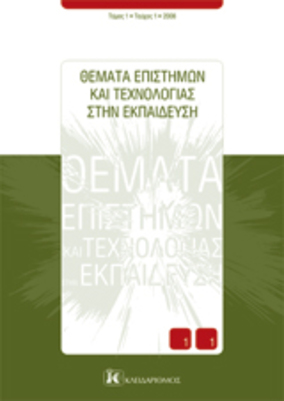Διερεύνηση της συνέπειας εφαρμογής των αντιλήψεων των μαθητών Λυκείου σε έννοιες της μηχανικής
Part of : Θέματα επιστημών και τεχνολογίας στην εκπαίδευση ; Vol.6, No.1-2, 2013, pages 37-48
Issue:
Pages:
37-48
Abstract:
Η σύγχρονη διδακτική προσέγγιση στοχεύει στη σύγκρουση των μαθητών με τις εναλλακτικές τους ιδέες έτσι ώστε να προκληθεί η ανατροπή τους και να ακολουθήσει αναδόμηση νόμων αρχών και εννοιών με βάση την επιστημονική γνώση. Το παραπάνω εγχείρημα βρίσκει σθεναρή αντίσταση που πηγάζει από την επιμονή των μαθητών να ερμηνεύουν τα φαινόμενα της καθημερινής τους ζωής χρησιμοποιώντας τις εναλλακτικές ιδέες τους και μάλιστα να βρίσκουν επαρκή αιτιολόγηση γι’ αυτά. Αποτέλεσμα είναι να γίνεται χρήση της επιστημονικής γνώσης, των εναλλακτικών ιδεών τους καθώς και ενός συνδυασμού αυτών ανάλογα με την κατάσταση που περιγράφεται στο πρόβλημα χωρίς να λαμβάνουν υπόψη τους, τους νόμους και τις αρχές που διέπουν τα φαινόμενα. Έτσι η συνέπεια που εμφανίζουν στη χρησιμοποίηση των ιδεών τους είτε πρόκειται για τις ορθές είτε για τις εναλλακτικές είναι μικρή.
Subject:
Subject (LC):
Keywords:
αντιλήψεις μαθητών, έννοιες μηχανικής, δευτεροβάθμια εκπαίδευση
Notes:
Περιέχει σχήματα, πίνακες και βιβλιογραφία
References (1):
- Champagne, A., Klopfer L., & Anderson J. (1980). Factors influencing the learning of classic mechanics. AmericanJournal of Physics, 48(12), 1074-1079.diSessa A., Gillespie N., & Esterly J. (2004). Coherence versus fragmentation in the development of the concept offorce. Cognitive Science, 28, 843-900.diSessa, A. (1993). Toward an epistemology of physics. Cognition and Instruction, 10(2/3), 105-225.Halloun I. (2006). Inventories of Basic Conceptions. www.Halloun.netHalloun, I., & Hestenes, D. (1985a). Common sense concepts about motion. American Journal of Physics, 53(11),1056-1065.Halloun I., & Hestenes D. (1985b). The initial knowledge state of college physics students. American Journal ofPhysics, 53(11), 1043-1055.Hammer, D. (1996). More than misconceptions: Multiple perspectives on student knowledge and reasoning, andan appropriate role for education research. American Journal of Physics, 64(10), 1316-1325.Hestenes, D., & Wells, M. (1992). A Mechanics Baseline Test. The Physics Teacher, 30(3), 159-166.Hestenes, D., Wells, M., & Swackhamer, G. (1992). Force Concept Inventory. The Physics Teacher, 30, 141-158Ioannides, C., & Vosniadou, S. (2002). Exploring the Changing Meaning of Force: From Coherence toFragmentation. Cognitive Science Quarterly, 2, 5–61.Itza–Ortiz, S., Rebello, S., & Zollman, D. (2004). Students’ models of Newton’s second law in mechanics andelectromagnetism. European Journal of Physics, 25, 81-89Maloney, D. (1984). Rule-governed approaches to physics - Newton’s third law. Physics Education, 19(1), 37-42.Minstrell, J. (1982). Explaining the at rest condition of an object. The Physics Teacher, 20, 10-14.Osborne, R. (1984). Children’s dynamics. The Physics Teacher, 22(8), 504-508.Özdemir, G., & Clark, D. B. (2007). An overview of conceptual change theories. Eurasia Journal of Mathematics.Science & Technology Education, 3(4), 351-361Sabanand, N., & Kess, J. (1990). Concepts in force and motion. The Physics Teacher, 28(8), 530-533.Sequeira, M., & Leite, L. (1991). Alternative conceptions and history of science in physics teacher education.Science Education, 75, 45.Thornton, R., & Sokoloff, D. (1998). Assessing student learning of Newton’s laws: The force and motionconceptual evaluation and the evaluation of active learning laboratory and lecture. American Journal of Physics,66(4), 228-351.Thornton, R. (1997). Conceptual dynamics: Following changing student views of force and motion. In E.F. Redish& J.S. Rigden (eds.), Thinking physics for teaching, Proceedings of ICUPE, 399, New York, American Instituteof PhysicsVan Heuvelen, Α. (1991). Learning to think like a physicist: A review of research-based instructional strategies.American Journal of Physics, 59(10), 891- 897.Viennot, L. (1979). Spontaneous seasoning in elementary dynamics. European Journal Science Education, 1(2), 205-221.Arons A. (1990). Οδηγός Διδασκαλίας της Φυσικής. Αθήνα: Εκδόσεις Τροχαλία.Driver, R., Squires, A., Rushworth, P., & Wood-Robinson, V. (2000). Οικο-Δομώντας τις Έννοιες των ΦυσικώνΕπιστημών. Μια παγκόσμια σύνοψη των ιδεών των μαθητών. Αθήνα: ΤΥΠΩΘΗΤΩ.Knight, R. (2006). Πέντε εύκολα μαθήματα–Στρατηγικές για την επιτυχή διδασκαλία της Φυσικής. Εκδόσεις Δίαυλος.Καράογλου, Γ., Κώτσης, Κ., & Ρίζος, Ι. (2010). Η χρήση του I.B.C.M για την ανάδειξη του τρόπου εφαρμογής τωννόμων του Newton στις συλλογιστικές δομές των μαθητών της Α΄ Λυκείου. Θέματα Επιστημών και Τεχνολογίαςστη Εκπαίδευση, 3(1), 17-30.Καράογλου, Γ., Κώτσης, Κ., & Ρίζος, Ι. (2010). Μελέτη των εναλλακτικών ιδεών στην έννοια της κίνησης, σεμαθητές της Α΄ Λυκείου, με τη χρήση του I.B.C.M. Θέματα Επιστημών και Τεχνολογίας στη Εκπαίδευση, 3(2), 85-95.




